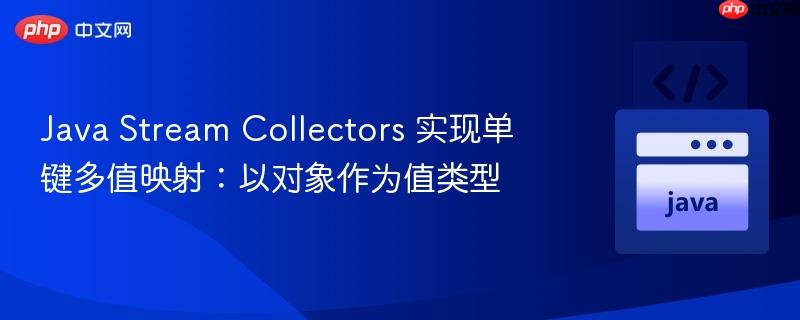
本文探讨如何利用 Java Stream API 和 Collectors 优雅地实现单键多值映射的需求。当一个键需要关联多个相关属性时,常见的误区是尝试直接映射到多个独立值。正确的策略是将键映射到一个包含所有所需属性的完整对象,从而简化代码、增强数据模型,并确保数据的完整性。
在现代 Java 应用开发中,处理集合数据并将其转换为特定结构(如 Map)是常见的操作。Java Stream API 结合 Collectors 提供了强大且声明式的方式来完成这些任务。一个典型的场景是将一个实体列表转换为一个 Map,其中 Map 的键是实体的唯一标识符,值是该实体的某个特定属性。
例如,我们可能有一个 UserProfile 实体,它包含 UserId、name 和 email 等属性。如果最初的需求只是将 UserId 映射到 email,代码可能如下所示:
import java.util.List;
import java.util.Map;
import java.util.Optional;
import java.util.concurrent.CompletableFuture;
import java.util.stream.Collectors;
import java.util.function.Function;
// 假设 UserId 和 UserProfile 类已定义
class UserId {
private String id;
public UserId(String id) { this.id = id; }
public String getId() { return id; }
@Override public boolean equals(Object o) { /* ... */ return true; }
@Override public int hashCode() { /* ... */ return 0; }
@Override public String toString() { return "UserId{" + "id='" + id + '\'' + '}'; }
}
class UserProfile {
private UserId userId;
private String name;
private String email;
public UserProfile(UserId userId, String name, String email) {
this.userId = userId;
this.name = name;
this.email = email;
}
public UserId getUserId() { return userId; }
public String getName() { return name; }
public String getEmail() { return email; }
}
public class UserProfileMapper {
public static void main(String[] args) {
// 模拟异步获取的 UserProfile 列表
List<CompletableFuture<Optional<UserProfile>>> futureList = List.of(
CompletableFuture.completedFuture(Optional.of(new UserProfile(new UserId("user1"), "Alice", "alice@example.com"))),
CompletableFuture.completedFuture(Optional.of(new UserProfile(new UserId("user2"), "Bob", "bob@example.com"))),
CompletableFuture.completedFuture(Optional.empty()) // 模拟一个空结果
);
// 原始需求:将 UserId 映射到 Email
Map<UserId, String> userIdToEmailMap = futureList.stream()
.map(CompletableFuture::join) // 等待 CompletableFuture 完成并获取 Optional<UserProfile>
.filter(Optional::isPresent) // 过滤掉空的 Optional
.map(Optional::get) // 获取 Optional 内部的 UserProfile 对象
.collect(Collectors.toMap(
UserProfile::getUserId, // 键映射器:使用 UserProfile 的 userId
UserProfile::getEmail // 值映射器:使用 UserProfile 的 email
));
System.out.println("UserId to Email Map: " + userIdToEmailMap);
}
}然而,当需求演变为需要将同一个 UserId 映射到 name 和 email 两个属性时,我们不能简单地在 Collectors.toMap 中添加第三个值映射器。Collectors.toMap 的第三个参数通常是一个合并函数,用于处理键冲突,而不是用于指定多个值。直接尝试这样做会导致编译错误或不符合预期的行为。
立即学习“Java免费学习笔记(深入)”;
解决单键多值映射问题的最佳实践是,当这些“多值”实际上是同一个实体对象的不同属性时,将键直接映射到该完整的实体对象。这样,Map 的值类型就变成了包含所有所需属性的对象本身。
在我们的 UserProfile 示例中,name 和 email 都属于 UserProfile 对象。因此,我们可以将 UserId 映射到 UserProfile 对象本身。
修改后的代码如下:
import java.util.List;
import java.util.Map;
import java.util.Optional;
import java.util.concurrent.CompletableFuture;
import java.util.function.Function;
import java.util.stream.Collectors;
// UserId 和 UserProfile 类定义同上
public class UserProfileMapper {
public static void main(String[] args) {
List<CompletableFuture<Optional<UserProfile>>> futureList = List.of(
CompletableFuture.completedFuture(Optional.of(new UserProfile(new UserId("user1"), "Alice", "alice@example.com"))),
CompletableFuture.completedFuture(Optional.of(new UserProfile(new UserId("user2"), "Bob", "bob@example.com"))),
CompletableFuture.completedFuture(Optional.empty())
);
// 新需求:将 UserId 映射到 UserProfile 完整对象
Map<UserId, UserProfile> userIdToProfileMap = futureList.stream()
.map(CompletableFuture::join) // 等待 CompletableFuture 完成
.filter(Optional::isPresent) // 过滤掉空的 Optional
.map(Optional::get) // 获取 Optional 内部的 UserProfile 对象
.collect(Collectors.toMap(
UserProfile::getUserId, // 键映射器:使用 UserProfile 的 userId
Function.identity() // 值映射器:使用 UserProfile 对象本身作为值
));
System.out.println("UserId to UserProfile Map: " + userIdToProfileMap);
// 如何访问 name 和 email:
UserProfile user1Profile = userIdToProfileMap.get(new UserId("user1"));
if (user1Profile != null) {
System.out.println("User1 Name: " + user1Profile.getName());
System.out.println("User1 Email: " + user1Profile.getEmail());
}
UserProfile user2Profile = userIdToProfileMap.get(new UserId("user2"));
if (user2Profile != null) {
System.out.println("User2 Name: " + user2Profile.getName());
System.out.println("User2 Email: " + user2Profile.getEmail());
}
}
}代码解析:
通过这种方式,我们得到了一个 Map<UserId, UserProfile>,其中每个 UserId 都映射到其对应的完整 UserProfile 对象。之后,我们可以通过 Map 获取 UserProfile 对象,并进一步访问其 getName() 或 getEmail() 等方法,从而间接实现了单键多值(属性)的映射。
.collect(Collectors.toMap(
UserProfile::getUserId,
Function.identity(),
(existing, replacement) -> existing // 如果键冲突,保留现有值
));总之,当需要将一个键映射到多个相关属性时,最优雅且推荐的 Java Stream 解决方案是利用 Collectors.toMap 将键映射到包含这些属性的完整实体对象。这不仅简化了代码,还保持了数据模型的完整性和一致性。
以上就是Java Stream Collectors 实现单键多值映射:以对象作为值类型的详细内容,更多请关注php中文网其它相关文章!

每个人都需要一台速度更快、更稳定的 PC。随着时间的推移,垃圾文件、旧注册表数据和不必要的后台进程会占用资源并降低性能。幸运的是,许多工具可以让 Windows 保持平稳运行。

Copyright 2014-2025 https://www.php.cn/ All Rights Reserved | php.cn | 湘ICP备2023035733号